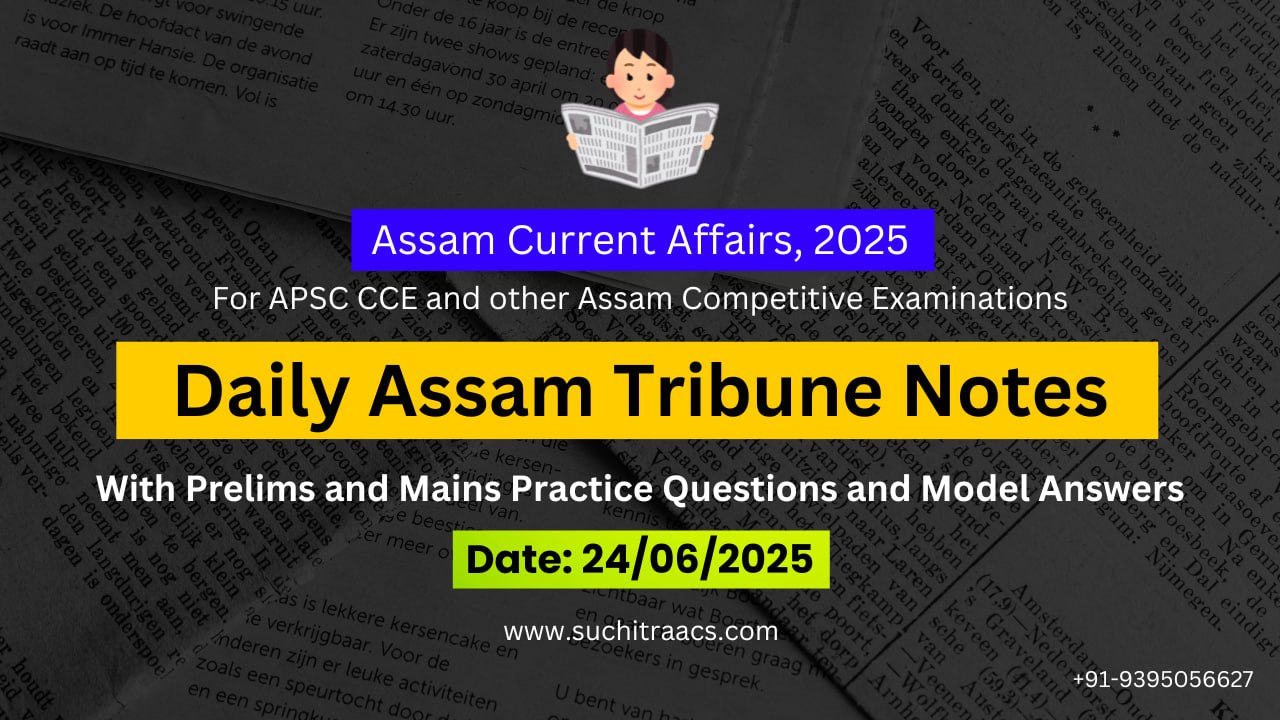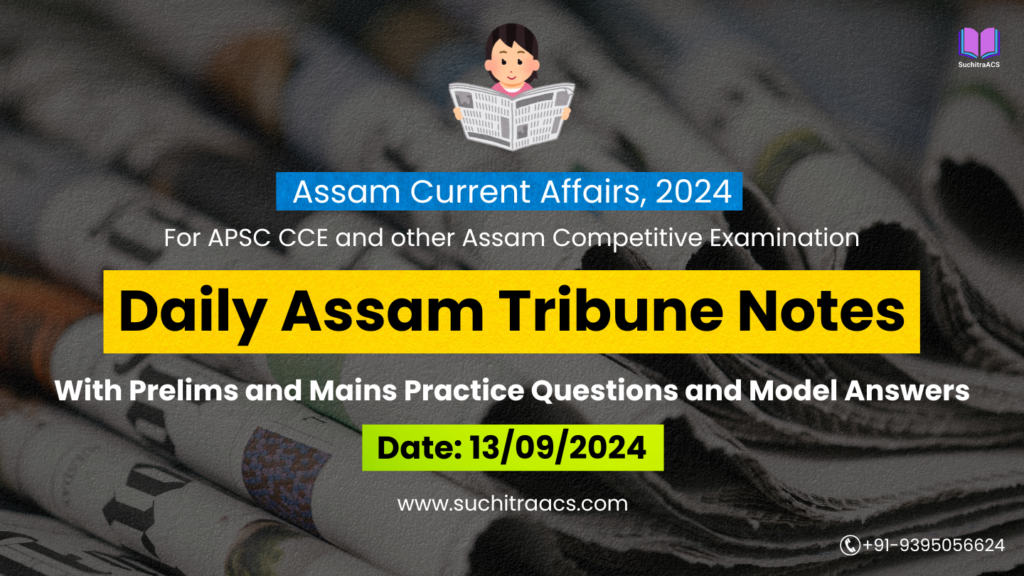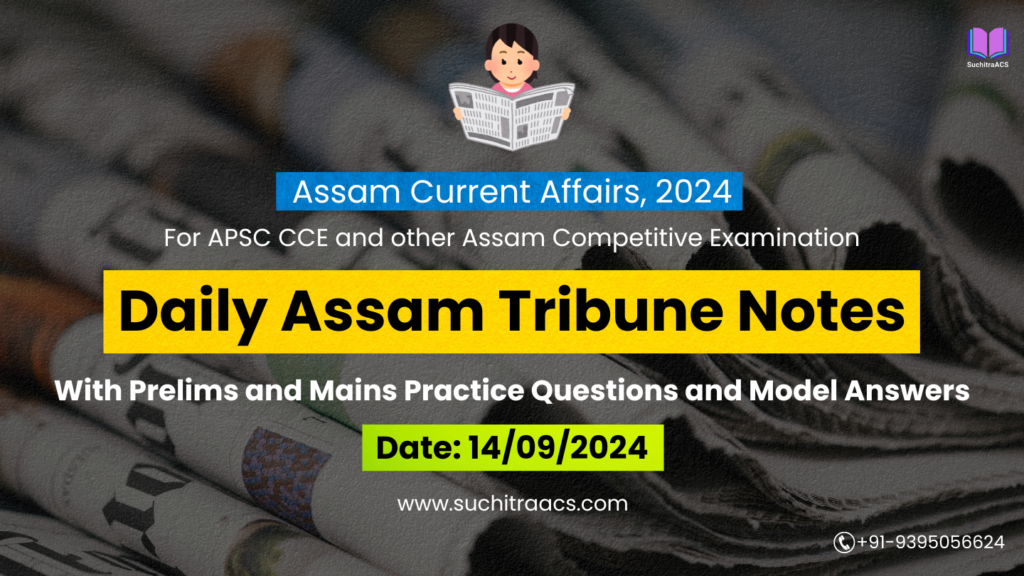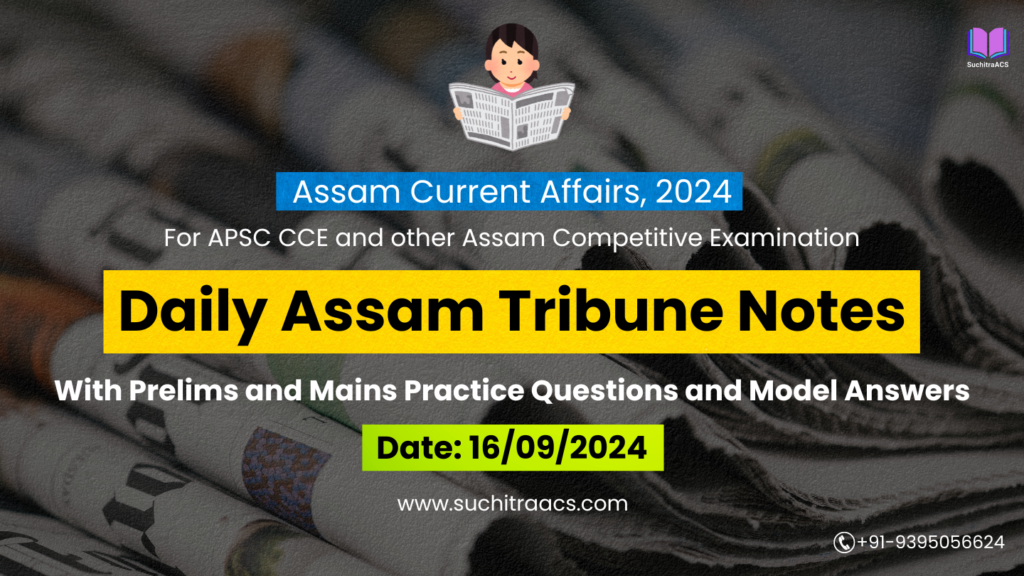APSC Current Affairs: Assam Tribune Notes with MCQs and Answer Writing (25/06/2025)
For APSC CCE and other Assam Competitive examinations aspirants, staying updated with current affairs is vital. This blog covers most important topics from the Assam Tribune today (25-06-2025). These issues are key for both APSC Prelims and Mains preparation, offering insights into the APSC CCE Syllabus.
✨ APSC CCE Online Coaching, 2026

🛢️ Crude Oil Crisis Averted After Iran-Israel Ceasefire: Implications for India
📘 GS Paper 2: International Relations | India & West Asia
📘 GS Paper 3: Energy Security | Economy | Strategic Resources
📘 APSC GS Paper 5: Assam’s Vulnerabilities to Global Oil Prices
🔹 Introduction
The escalation between Iran and Israel threatened a major disruption in global crude oil supply. With India importing over 85% of its oil needs, the temporary spike in oil prices posed economic and strategic risks. However, a ceasefire has helped stabilize prices, providing temporary relief for oil-dependent economies like India.
🔑 Key Developments
| Event | Details |
| 🔺 Conflict Duration | 12 days – included missile strikes and retaliatory actions |
| 🌍 Strategic Chokepoint Threat | Iran threatened to close the Strait of Hormuz, a key route for 20% of global oil trade |
| 📉 Price Volatility | Crude oil prices jumped to $79/barrel during conflict, dropped to $65/barrel post-ceasefire |
| 🇮🇳 India’s Daily Oil Import | Approx. 5 million barrels/day |
| 🛢️ Major Suppliers to India | Russia, Saudi Arabia, UAE, US (not Iran) |
| ⚠️ Economic Risk for India | Import bill rise, inflation, subsidy burden |
| 🧭 Govt Measures Initiated | Directive to boost domestic production via OIL & ONGC |
🧠 Prelims Pointers
Strait of Hormuz: Located between the Persian Gulf and Gulf of Oman; critical for India’s West Asia energy imports.
India’s Oil Import Dependence: ~87% as of 2024–25
Strategic Petroleum Reserve (SPR): India’s buffer against global price shocks
Top Crude Suppliers (2024–25): Russia > Saudi Arabia > UAE > Iraq
Operation Sindhu: India’s evacuation effort during Iran-Israel conflict
📝 Mains Pointers
A. Significance for India
Energy Security: Stable oil supply critical for power, transport, and industry
Economic Stability: High oil prices widen trade deficit, fuel inflation
Foreign Policy: Balancing relations with West Asia and Israel
Strategic Autonomy: Highlights need for non-aligned, interest-driven diplomacy
B. Strategic Challenges
| Challenge | Explanation |
| ⚠️ Volatile Oil Market | Highly sensitive to West Asian geopolitics |
| 🧾 Rising Import Bill | Makes Indian rupee vulnerable, increases fiscal pressure |
| 🏭 Slow Domestic Production | Domestic oil production not rising fast enough |
| 🗺️ Lack of Diversification | Still heavily dependent on traditional suppliers |
C. Government Initiatives
Hydrocarbon Exploration and Licensing Policy (HELP)
National Bio-Energy Mission and Ethanol Blending Targets (20% by 2025)
International Solar Alliance (ISA) for energy diversification
Boost to ONGC & OIL to explore domestic reserves
Expansion of Strategic Petroleum Reserves in Chandikhol (Odisha), Padur (Karnataka)
🧭 Way Forward
| Measure | Suggested Action |
| 🌞 Diversify Energy Mix | Promote solar, wind, biofuels |
| 🛢️ Expand SPR | Build 90–120 days’ reserve capacity |
| 🤝 Strengthen Diplomacy | Proactive engagement with OPEC+, Iran, Israel |
| 🧬 Invest in Green Alternatives | Hydrogen Mission, EV push |
| 🚆 Transport Reforms | Improve rail and inland water freight to cut diesel use |
🧩 Conclusion
The ceasefire between Iran and Israel has provided short-term relief, but it has also re-emphasized India’s strategic vulnerability to external shocks in the oil market. To ensure long-term energy and economic security, India must focus on diversification, domestic production, and renewable energy transition.
📉 Rising Youth Suicides in Assam: A Growing Mental Health Crisis
📘 GS Paper 2: Issues Related to Health | Government Policies
📘 GS Paper 4: Ethics – Empathy, Emotional Intelligence, Public Service Values
📘 GS Paper 5 (APSC): Assam – Social Issues | Health Infrastructure | Youth Policy
🔹 Introduction
The NCRB data and recent reports from Assam reveal a disturbing trend: an alarming rise in suicides among youth aged 15–29, particularly among students and unemployed rural youth. Experts point to exam pressure, digital isolation, job insecurity, and mental health stigma as driving causes. The issue is fast evolving into a silent epidemic that demands urgent institutional and societal response.
🔑 Key Facts and Data
| Indicator | Statistic / Trend |
| 📊 Age Group Most Affected | 15–29 years |
| 📉 Primary Causes | Academic stress, joblessness, social isolation |
| 🧠 Mental Health Access | 1 psychiatrist per ~1 lakh population in Assam |
| 📱 Digital Addiction | Correlated with rising anxiety and sleep issues |
| 🧾 Recent Cases | Series of suicides in Nalbari, Dibrugarh, and Silchar |
| 🔍 Reporting Body | Assam Health Dept. + NCRB 2024 provisional data |
🧠 Prelims Pointers
NCRB: National Crime Records Bureau – maintains suicide statistics annually
Manodarpan Initiative: Launched by MoE for student mental health support
District Mental Health Programme (DMHP): Under NMHP, implemented via NHM
Tele MANAS: India’s digital mental health helpline
Section 309 IPC: Decriminalised attempted suicide under MHCA 2017
📝 Mains Pointers
A. Root Causes of the Crisis
| Cause | Impact |
| 📚 Academic Pressure | Parental/social expectations, fear of failure |
| 💼 Employment Anxiety | Lack of job avenues post-graduation |
| 📵 Digital Disconnection | Social media-induced anxiety and cyberbullying |
| 🏥 Poor Mental Health Access | Inadequate counselling at school and college levels |
| 🔇 Stigma & Silence | Reluctance to seek help due to shame or ignorance |
B. Assam-Specific Concerns
Rural youth isolated post-COVID with limited digital literacy
Many students from BPL backgrounds lack peer or career guidance
High suicide reporting in tea garden communities and urban slums
Lack of child psychologists in public schools
Poor coordination between Education, Labour, and Health Departments
C. Policy Interventions So Far
Manodarpan Cell in SCERT Assam
Assam Adolescent Health Programme – peer educator model
Counsellor Recruitment under Samagra Shiksha (slow pace)
Helplines and Peer Groups via college NSS/NCC units
Proposal for State Mental Health Authority under review
🧭 Way Forward
| Recommendation | Strategy |
| 👥 School Mental Health Teams | Full-time psychologist + counsellor per school cluster |
| 📱 Mobile Mental Health Vans | For underserved rural districts |
| 🧑🏫 Mental Health Curriculum | Empathy, self-regulation, life skills in syllabus |
| 🏥 Strengthen DMHP Infrastructure | 24/7 helplines, district-level OPD for adolescents |
| 🎓 Career Guidance in Colleges | NSS/NCC-led mentoring, job-linked counselling |
🧩 Conclusion
Youth suicides are not just health failures—they are a moral and social crisis. Assam must act with urgency, compassion, and policy innovation to create a safety net of hope, support, and opportunity for its young population. Mental health cannot remain a peripheral concern—it must be mainstreamed across sectors.
🏞️ Assam’s First Biodiversity Heritage Site Proposed in Majuli
📘 GS Paper 3: Environment – Biodiversity | Conservation | Ecology
📘 GS Paper 5 (APSC): Assam – Ecological Heritage | Community Conservation
🔹 Introduction
The Assam State Biodiversity Board (ASBB) has proposed Majuli Island as the state’s first Biodiversity Heritage Site (BHS) under Section 37 of the Biological Diversity Act, 2002. The proposal aims to protect Majuli’s unique wetland ecosystem, floodplains, and cultural landscape, combining ecological and spiritual heritage.
🔑 Key Features of the Proposal
| Feature | Description |
| 🗺️ Location | Majuli – World’s largest inhabited river island |
| 📜 Legal Basis | Section 37 of the Biological Diversity Act, 2002 |
| 🧬 Ecological Components | Floodplain wetlands, fish species, aquatic plants, migratory birds |
| 🧘♂️ Cultural Link | Home to neo-Vaishnavite Satras; links between biodiversity and rituals |
| 🌊 Threats | Erosion, tourism pressure, plastic waste, habitat fragmentation |
| 🧭 Implementing Authority | Assam State Biodiversity Board (ASBB) + Local BMCs |
🧠 Prelims Pointers
Biodiversity Heritage Site (BHS): Notified area under BD Act, 2002 for unique ecosystems
ASBB: Assam State Biodiversity Board – regulates conservation and People’s Biodiversity Registers (PBRs)
Majuli: Declared district in 2016; known for Satras, rice biodiversity, and wetland culture
PBRs: Community documents on local biological resources and traditional knowledge
India’s First BHS: Nallur Tamarind Grove, Karnataka
📝 Mains Pointers
A. Importance of Declaring Majuli as BHS
| Dimension | Significance |
| 🌿 Ecological | Rich in indigenous fish, orchids, riverine flora |
| 📜 Cultural | Biodiversity tied to monastic Vaishnavite traditions |
| 💧 Hydrological | Wetlands act as flood buffers and water recharge zones |
| 🧑🌾 Livelihoods | Supports fishing, weaving, and eco-tourism |
| 📚 Educational | Ideal for biodiversity learning and awareness |
B. Major Environmental Threats
Rapid bank erosion due to Brahmaputra’s dynamic course
Plastic and sewage pollution from tourist influx
Climate change altering migratory bird patterns and monsoon
Loss of native crop varieties and aquatic biodiversity
Weak enforcement of conservation norms at local level
C. Legal and Policy Context
Biological Diversity Act, 2002 – Section 37 empowers states to declare BHS
India’s National Biodiversity Action Plan (NBAP)
State Wetland Authority and Forest Dept – responsible for site monitoring
Eco-sensitive Zone Guidelines for peripheral land-use regulation
UNESCO Biosphere Reserve Framework (Majuli not listed yet, but eligible)
🧭 Way Forward
| Recommendation | Strategy |
| 📃 Formal BHS Notification | Complete due process with Gram Sabha endorsement |
| 👥 Local BMC Empowerment | Fund and train Biodiversity Management Committees |
| 🗺️ GIS-Based Mapping | Digital demarcation of biodiversity zones |
| 🧑🎓 Community Ecotourism | Low-impact tourism guided by trained local youth |
| 📚 Curriculum Integration | Satras and biodiversity link in Assamese textbooks |
🧩 Conclusion
Designating Majuli as Assam’s first Biodiversity Heritage Site is a visionary ecological and cultural step. It reflects the potential of blending traditional wisdom, scientific planning, and grassroots involvement to preserve Assam’s fragile ecosystems.
APSC Prelims Practice Questions
✅ Topic 1: Crude Oil Crisis Averted – Iran–Israel Ceasefire
1. The Strait of Hormuz is strategically important because:
A. It connects the Red Sea to the Mediterranean Sea
B. It is the only route to the Indian Ocean from Europe
C. It serves as a key chokepoint for global crude oil trade ✅
D. It links the Suez Canal to the Arabian Sea
🧠 Explanation:
The Strait of Hormuz, located between the Persian Gulf and Gulf of Oman, is the world’s most important oil chokepoint, through which ~20% of global oil flows.
2. Which of the following countries are among India’s top crude oil suppliers (2024–25)?
- Russia
- Saudi Arabia
- Iran
- United Arab Emirates
Select the correct answer:
A. 1, 2 and 4 only ✅
B. 1, 2 and 3 only
C. 2, 3 and 4 only
D. All of the above
🧠 Explanation:
India currently does not import oil from Iran due to U.S. sanctions. The major suppliers are Russia, Saudi Arabia, and the UAE.
✅ Topic 2: Rising Youth Suicides in Assam
3. Which of the following initiatives is directly aimed at supporting student mental health in India?
A. National Digital Health Mission
B. NISHTHA Training Platform
C. Manodarpan Initiative ✅
D. Poshan Abhiyaan
🧠 Explanation:
Manodarpan, launched under the Ministry of Education, addresses mental well-being of students, teachers, and families, including a national helpline.
4. Under the Mental Healthcare Act, 2017, what is the legal status of attempted suicide in India?
A. Punishable under IPC 309
B. Punishable only if done twice
C. Completely decriminalised
D. Decriminalised if proven mental distress ✅
🧠 Explanation:
Section 115 of the Mental Healthcare Act, 2017 decriminalises attempted suicide if it is due to severe stress, presuming the person needs care, not punishment.
✅ Topic 3: Majuli Proposed as Assam’s First Biodiversity Heritage Site
5. What is the legal basis for declaring a Biodiversity Heritage Site (BHS) in India?
A. Environment Protection Act, 1986
B. Forest Rights Act, 2006
C. Biological Diversity Act, 2002 ✅
D. Wildlife Protection Act, 1972
🧠 Explanation:
Section 37 of the Biological Diversity Act, 2002 empowers state governments to notify areas of ecological importance as Biodiversity Heritage Sites (BHS).
6. Which of the following are commonly found in a People’s Biodiversity Register (PBR)?
- Traditional knowledge of local medicinal plants
- Inventory of flora and fauna in a village
- Geo-political boundaries of Gram Panchayats
- Details of local community practices
Select the correct code:
A. 1, 2 and 4 only ✅
B. 1 and 3 only
C. 2 and 3 only
D. All of the above
🧠 Explanation:
PBRs are documents maintained by Biodiversity Management Committees (BMCs) and include local biodiversity knowledge, species inventory, and community practices, but not geopolitical boundaries.
APSC Mains Practice Question
📝 Mains Question:
Q. Discuss the significance of declaring Majuli as a Biodiversity Heritage Site (BHS) under the Biological Diversity Act, 2002. What challenges are involved in the conservation of river island ecosystems like Majuli, and how can they be addressed?
📘 Model Answer
Introduction
Majuli, the world’s largest inhabited river island and a cultural hub of neo-Vaishnavism, has been proposed by the Assam State Biodiversity Board (ASBB) as Assam’s first Biodiversity Heritage Site (BHS) under Section 37 of the Biological Diversity Act, 2002. Recognizing Majuli as a BHS is both an ecological and cultural imperative in the face of mounting environmental pressures.
Significance of BHS Status for Majuli
| Domain | Contribution |
| 🌿 Ecological | Protects wetland biodiversity, fish species, migratory birds, and rare flora |
| 🧘♂️ Cultural | Preserves traditional eco-sensitive practices of Vaishnavite Satras |
| 🌾 Economic | Supports sustainable livelihoods like fishing, handloom, and ecotourism |
| 🌊 Hydrological | Wetlands and floodplains act as natural buffers during monsoons |
| 🧑🎓 Educational | Becomes a living lab for biodiversity education and citizen science |
Why Majuli Is Ecologically Unique
- Home to over 100+ species of fish, orchids, and aquatic vegetation
- Lies in the Brahmaputra floodplain, highly dynamic and fertile
- Key stopover for Central Asian migratory birds
- Known for organic rice varieties and wetland-based agriculture
- Site of community conservation traditions, e.g., xatras planting sacred groves
Challenges in Conserving River Island Ecosystems
| Challenge | Explanation |
| 🌊 Erosion by Brahmaputra | Majuli has lost over 30% landmass in 100 years |
| 🚧 Infrastructure Pressure | Roads, embankments disrupt wetland hydrology |
| 🧴 Tourism-linked Pollution | Plastic, sewage, and over-tourism near Satras |
| 🌱 Invasive Species | Water hyacinth and alien fishes disrupting wetland ecosystems |
| 📋 Poor Policy Enforcement | Weak BMC presence and lack of coordination among agencies |
Legal and Policy Framework
- Biological Diversity Act, 2002 – BHS declaration by state governments
- Wetland Rules, 2017 – Legal protection for notified wetlands
- State Biodiversity Board & BMCs – Key implementing agencies
- Eco-sensitive Zone (ESZ) Notification – Can regulate tourism and construction
- National Biodiversity Action Plan (NBAP) – India’s roadmap to protect key ecosystems
Way Forward
| Solution Area | Strategic Action |
| 📜 BHS Notification Process | Complete Gram Sabha consultation and GIS demarcation |
| 👥 Strengthen BMCs | Train locals to prepare People’s Biodiversity Registers (PBRs) |
| 🚫 Regulate Tourism | Eco-certification, waste control, and visitor caps |
| 🌊 Flood Management | Use soft engineering and wetland buffers over embankments |
| 📚 Eco-education | Include Satras and Majuli’s biodiversity in school curriculum |
Conclusion
Declaring Majuli as a Biodiversity Heritage Site is not just symbolic—it is a strategic step to conserve a fragile river island that embodies Assam’s ecological richness and cultural depth. If implemented with community participation and strong governance, Majuli can become a model for integrated riverine conservation in India.
✨ APSC CCE Courses, 2025-26 offered by SuchitraACS
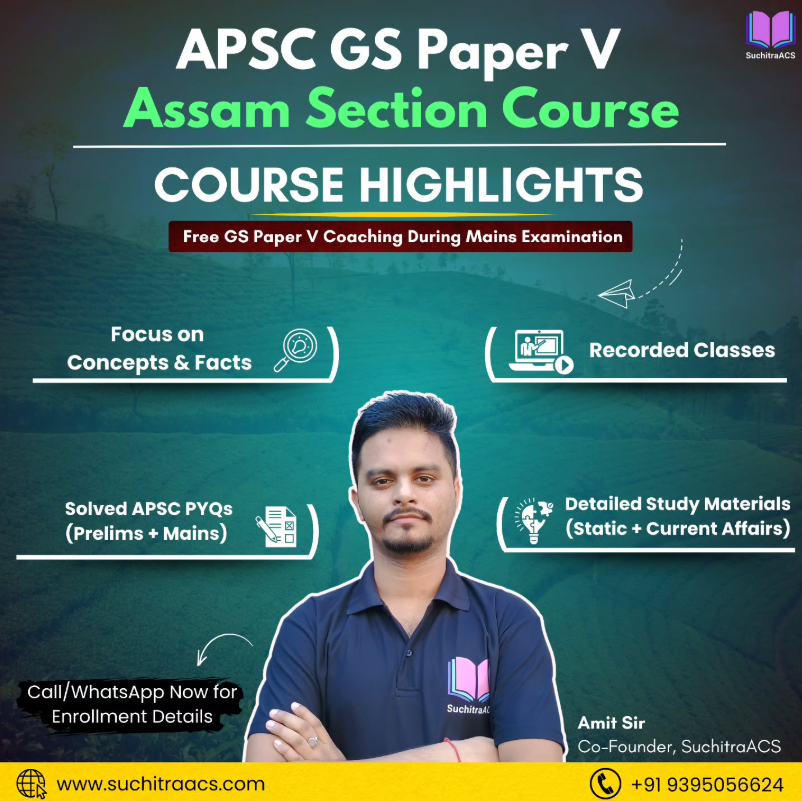

🔔 Join Our WhatsApp Study Group!
For exclusive access to premium quality content, including study materials, current affairs, MCQs, and model answers for APSC CCE and other Assam competitive exams.
Click here to join: SuchitraACS Study WhatsApp Group
📚 Want to know more about SuchitraACS’s most affordable courses?
Click here to know more: SuchitraACS Courses for APSC CCE and Assam Competitive Examinations

